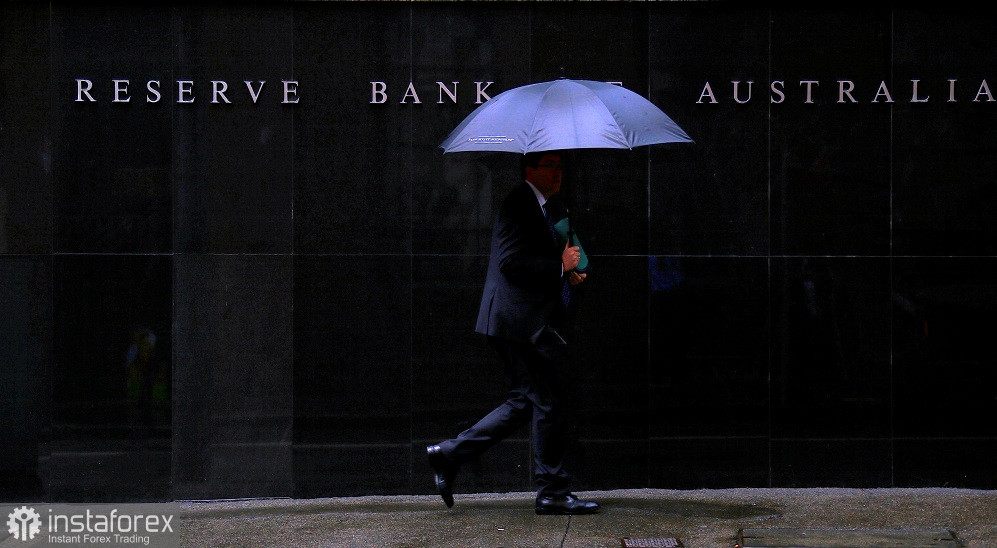The AUD/USD currency pair hit an almost 11-month low on Tuesday, plunging to the 0.6360 mark. The impulsive price decline was driven by the strengthening of the greenback amid rising risk-off sentiment and the weakening Aussie.
The Australian dollar reacted negatively to the outcomes of the September RBA meeting, where central bank representatives adopted a wait-and-see stance and expressed rather cautious rhetoric. This combination of fundamental factors allowed the AUD/USD bears to shift the situation in their favor after several weeks of sideways movement. However, despite bearish sentiments in the pair, considering short positions at this point is risky. As they say, "the train has left" – at least, the one from yesterday. However, long positions are not advisable in this scenario either, given the current fundamental backdrop. Today's corrective price rise appears quite fragile and unreliable.
It may be prudent, at this point, to adopt a wait-and-see position in the pair to enter short positions at a more favorable price. Certainly, the fate of the pair in the medium term will depend on the behavior of the U.S. currency. But it is essential to remember that the Australian dollar is still unable to assert itself, even in light of today's (relatively decent) release regarding Australia's economic growth.

Now, let's discuss the RBA. The outcomes of the September meeting of the Australian regulator exerted pressure on the Aussie as the central bank did not present any hawkish surprises. On the contrary, the bank confirmed its wait-and-see stance, while using somewhat vague wordings regarding the further tightening of monetary policy.
In essence, RBA officials left the door open for another rate hike this year, lamenting that inflation remains high and "will remain so for some time." However, this thesis has been voiced by the central bank at previous meetings, so this statement has become somewhat customary.
At the same time, some indirect signs suggest that the RBA is ready to maintain its wait-and-see position further, considering an additional rate hike as an extraordinary event. Firstly, the central bank indicated that the country's economic growth has slowed down. Secondly, the RBA pointed to increased uncertainty regarding the Chinese economy, characterizing it as a factor "affecting the growth forecast of the Australian economy." Additionally, the regulator stated that it would take into account the cumulative amount of monetary policy tightening from meeting to meeting and the lag effects of monetary policy, as well as monitor the dynamics of key macro indicators, primarily in the field of inflation.
All this indicates that the Reserve Bank of Australia will not rush to raise interest rates. According to some experts (particularly economists at TD Securities), it can now be said that the current tightening cycle of monetary policy is coming to an end. The central bank will resort to another rate hike only if inflation starts picking up again, as reflected in the data on consumer price index growth for the third quarter of this year (the report will be published at the end of October).
Thus, the overall tone of the accompanying statement and certain phrases in the final communique (particularly mentioning that the economy is experiencing below-trend growth) suggest that the Reserve Bank will raise rates only if inflation in Australia starts gaining momentum again in the third quarter. Given that the corresponding report is expected at the end of October, it can be assumed that the discussion of monetary policy tightening will not happen before November.
It is noteworthy that today's data on Australia's economic growth, published earlier, provided weak support for the Aussie. Although the report was in the "green zone," Australia's GDP increased by 2.1% year-on-year in the second quarter. On the one hand, the figure shows a declining trend (compared to 2.4% in the first quarter and 2.6% in the fourth quarter of 2022), but on the other hand, experts had forecasted a more modest growth rate of 1.8% year-on-year in the second quarter. Therefore, today's release can be interpreted differently – both in favor of the Aussie and against the Australian currency.
Overall, in my opinion, a bearish sentiment persists for the AUD/USD pair, so any corrective pullbacks should be seen as an opportunity to open short positions.
From a technical perspective, on the D1 timeframe, the pair is trading between the middle and lower Bollinger Bands lines, as well as below all the lines of the Ichimoku indicator, which has formed a bearish "Parade of Lines" signal. Sellers were unable to break the support level at 0.6360 (the lower Bollinger Bands line), after which buyers staged a counterattack towards the 0.6400 level. However, the technical picture suggests a preference for short positions, with the initial target at 0.6360. If bears manage to break this target, the next one will be 0.6320, which is the lower Bollinger Bands line on the W1 timeframe.
 English
English 
 Русский
Русский Bahasa Indonesia
Bahasa Indonesia Bahasa Malay
Bahasa Malay ไทย
ไทย Español
Español Deutsch
Deutsch Български
Български Français
Français Tiếng Việt
Tiếng Việt 中文
中文 বাংলা
বাংলা हिन्दी
हिन्दी Čeština
Čeština Українська
Українська Română
Română

